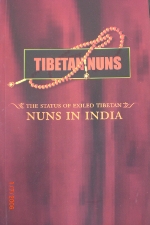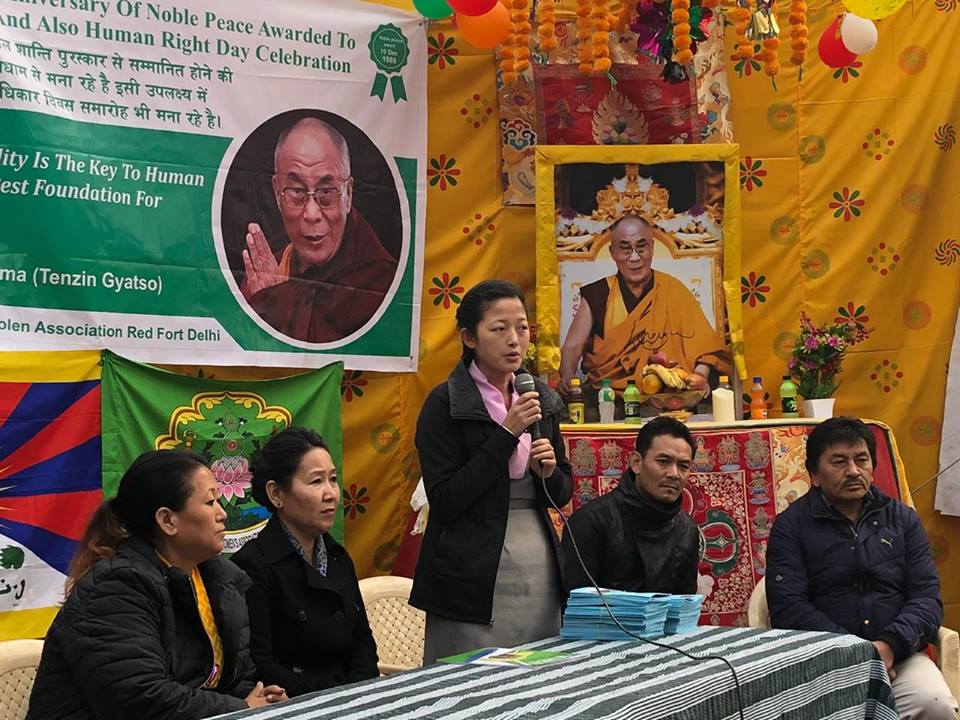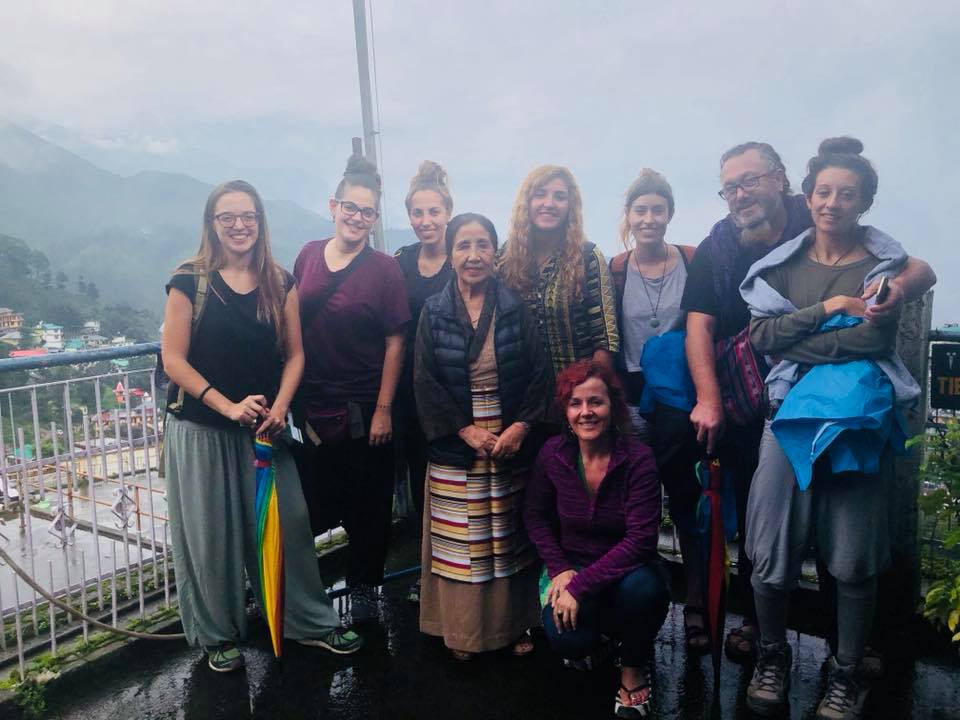TWA launches seven books to commemorate 50th anniversary
Marking fifty years of occupation, fifty years of repression, and fifty years of resistance, the Tibetan Women’s Association (TWA) honored the sacrifices and achievements of Tibetan women all over the world on March 12, 2009. Committed always to increasing international awareness of the plight of Tibetan women within Tibet, and to preserving the historical legacy of the women’s movement, TWA launched seven new publications in conjunction with their Fiftieth Anniversary commemoration.
Covering a wide range of topics, these seven new works seek to bridge the gap between past and future. The works include everything from the personal narratives of female activists, historical presentations of women’s struggles and the women’s movement, and a slew of new research regarding prevailing conditions for Tibetan women in Tibet and in exile. As there can be no forward progress without an accurate understanding of the past, of the battles fought and sacrifices made, and of the commitment and dedication that still drives Tibetan patriots today, TWA has fought consistently to provide the necessary historical lens through which to view the continued Tibetan struggle.
- Breaking the Shackles: 50 Years of Tibetan Women’s Struggle – view chapter one as PDF
 The new flagship work, Breaking the Shackles: 50 Years of Tibetan Women’s Struggle, sought directly to address this need, presenting the first comprehensively researched historical account of the women’s movement, from birth to the present day. Beginning with TWA’s inception during the Tibetan Women’s Uprising of March 12, 1959, Breaking the Shackles provides unprecedented research into the conditions and circumstances surrounding this monumental act of defiance. The first truly political action undertaken by Tibetan women, it simultaneously marked the emergence of Tibetan women as a potent political force. Through an extensive series of interviews, TWA was able to obtain firsthand witness accounts of the heroic resistance, tragic crackdown, and the subsequent mass exodus into exile. Breaking the Shackles also provides the only complete account of the women’s movement following the escape into exile. Drawing from a wealth of firsthand knowledge, along with academic research, the work illustrates the struggles of the first years and the tireless efforts of Tibetan women to hold the community together, socially and materially. Charting the growth of the original co-operative societies into the eventual re-establishment of TWA in 1984, Breaking the Shackles allows a glimpse into the immense challenges overcome by the first generation of Tibetan women in exile.
The new flagship work, Breaking the Shackles: 50 Years of Tibetan Women’s Struggle, sought directly to address this need, presenting the first comprehensively researched historical account of the women’s movement, from birth to the present day. Beginning with TWA’s inception during the Tibetan Women’s Uprising of March 12, 1959, Breaking the Shackles provides unprecedented research into the conditions and circumstances surrounding this monumental act of defiance. The first truly political action undertaken by Tibetan women, it simultaneously marked the emergence of Tibetan women as a potent political force. Through an extensive series of interviews, TWA was able to obtain firsthand witness accounts of the heroic resistance, tragic crackdown, and the subsequent mass exodus into exile. Breaking the Shackles also provides the only complete account of the women’s movement following the escape into exile. Drawing from a wealth of firsthand knowledge, along with academic research, the work illustrates the struggles of the first years and the tireless efforts of Tibetan women to hold the community together, socially and materially. Charting the growth of the original co-operative societies into the eventual re-establishment of TWA in 1984, Breaking the Shackles allows a glimpse into the immense challenges overcome by the first generation of Tibetan women in exile.
As the organization expanded rapidly both domestically and internationally, its mission and focus broadened as well. TWA’s concentration eventually came to cover a wide agenda centered on political activism along with a desire to address social issues ranging from poverty, to health, environment, and education. Breaking the Shackles follows this evolution, providing a comprehensive account of TWA actions and initiatives along all these fronts. Centered heavily upon the primary political directive, the publication highlights all the major political campaigns undertaken by both Central and Regional offices, for example, from official representation and participation at United Nations conventions and international forums, to direct action campaigning against the 2008 Beijing Olympic Games, to the ceaseless efforts to publicize the human rights atrocities taking place within Tibet.
Social initiatives are not neglected however, Breaking the Shackles, also presents a thorough account of the social welfare initiatives undertaken, from sponsorship programs, to women’s leadership and health workshops, to TWA’s integral role in the formation of the Tibetan Nun’s Project. An unparalleled overview of Tibetan women’s struggles and the activities of TWA, Breaking the Shackles preserves for posterity an account of the struggles, sacrifices, courage, and dedication of Tibetan women and serves as a milestone in the academic understanding of the women’s movement.
- Tibetan Nuns: The Status of Exiled Tibetan Nuns in India
 Released as a follow up to TWA’s seminal 2005 research Tibetan Women: The Status of Exiled Tibetan Women in India, Tibetan Nuns: The Status of Exiled Tibetan Nuns in India provides pioneering research into the lives and conditions of Tibetan nuns living in exile. Based upon results obtained from a randomly sampled survey of over 350 Tibetan nuns living in exile, this volume represents the first detailed look into the realities of the modern monastic system.
Released as a follow up to TWA’s seminal 2005 research Tibetan Women: The Status of Exiled Tibetan Women in India, Tibetan Nuns: The Status of Exiled Tibetan Nuns in India provides pioneering research into the lives and conditions of Tibetan nuns living in exile. Based upon results obtained from a randomly sampled survey of over 350 Tibetan nuns living in exile, this volume represents the first detailed look into the realities of the modern monastic system.
Covering a range of issues, from the state of education within nunneries, to the female monastic experience in both Tibetan and in exile, to the monastic-oriented understanding of gender issues and discrimination, Tibetan Nuns provides a lucid addition to the oft-neglected study of women within the monastic community. Research results are augmented within by TWA’s own interpretations, presented in conjunction with both policy prescriptions and recommendations for further inquiry. Tibetan Nuns provides a rare view into the radically changing female monastic community, and illuminates a modern nun that is often liberated from traditional religious constraints. A new generation has emerged through the expansion of education and new initiatives undertaken directly in support of nuns in exile that are poised to not only seize the administrative and theological reigns of their own institutions, but also to break into the rarified air of high level Tibetan Buddhist philosophy. Young, well-educated, dedicated, and politically conscious, these nuns represent a new breed defying the traditional stereotypes of the past.
- Tears of Silence: A Report on China’s Birth Control Policy in Tibet
 Commitment to the preservation of history and culture never supersedes TWA’s mission to effect substantive political change in Tibet and to protect Tibetan women living under Chinese rule. The completely revised fifth edition of Tears of Silence, investigates Chinese birth control policies in Tibet and the violations of Tibetan women’s fundamental rights of reproduction. Beginning with an overview of the most recent academic research into the state of reproductive rights within Tibet, Tears of Silence proceeds to provide a comprehensive account of official birth control policies, the coercion implicit in their often brutal implementation, and the profound impact that this is having upon Tibetan women and Tibetan society. Included within are seven case studies, the firsthand accounts illustrating the toll that such policies have upon individual lives and families.
Commitment to the preservation of history and culture never supersedes TWA’s mission to effect substantive political change in Tibet and to protect Tibetan women living under Chinese rule. The completely revised fifth edition of Tears of Silence, investigates Chinese birth control policies in Tibet and the violations of Tibetan women’s fundamental rights of reproduction. Beginning with an overview of the most recent academic research into the state of reproductive rights within Tibet, Tears of Silence proceeds to provide a comprehensive account of official birth control policies, the coercion implicit in their often brutal implementation, and the profound impact that this is having upon Tibetan women and Tibetan society. Included within are seven case studies, the firsthand accounts illustrating the toll that such policies have upon individual lives and families.
A comprehensive and dispassionate academic account, Tears of Silence provides a synthesis of currently available research. TWA follows this with its own recommendations and presentation of measures that can be undertaken to protect the reproductive rights of Tibetan women.
- Light in the Abyss: The Drapchi Fourteen
 In 1993, a cassette tape was smuggled out of Tibet’s most feared penal institution, the infamous Drapchi Prison. Filled with secret songs of resistance and religious dedication, it was broadcast to the world by the underground freedom movement in Lhasa. Hauntingly beautiful, the songs described, sometimes graphically, the brutal regime of beatings, deprivation, and torture endured on a daily basis behind the walls of Drapchi. Simultaneously, the songs expressed the deep conviction of faith, hope, and love that transcended this horror. Unbroken and defiant, the lyrics illustrated an enduring strength that has come to be synonymous with all Tibetan political prisoners.
In 1993, a cassette tape was smuggled out of Tibet’s most feared penal institution, the infamous Drapchi Prison. Filled with secret songs of resistance and religious dedication, it was broadcast to the world by the underground freedom movement in Lhasa. Hauntingly beautiful, the songs described, sometimes graphically, the brutal regime of beatings, deprivation, and torture endured on a daily basis behind the walls of Drapchi. Simultaneously, the songs expressed the deep conviction of faith, hope, and love that transcended this horror. Unbroken and defiant, the lyrics illustrated an enduring strength that has come to be synonymous with all Tibetan political prisoners.
Light in the Abyss presents the story of the fourteen nuns responsible for this stunning act of defiance and protest. All imprisoned for non-violent resistance activities, “Tibet’s Singing Nuns”, as they came to be known, personify the love and commitment that form the core of the Tibetan freedom struggle. Beginning with a historical analysis of the explosive 1987-1993 era, when an estimated 200 protests of various sizes took place, this volume includes a thorough account of the prison conditions within Drapchi, the conditions of the Chinese penal system as a whole, and an analysis of the Chinese judicial framework. Specific attention is given to the ideological basis behind China’s system of reform through labor, and the resulting torture, abuse, and exploitation.
A full account of the ‘Drapchi Fourteen’ follows, charting the initial arrests of each nun, their lives in prison, the circumstances of the recording, and their eventual release. Updated with new information gathered from interviews with the nuns themselves, Light in the Abyss provides biographical profiles for all fourteen, including their most recent whereabouts and situations.
- In Memory of the Martyrs
 The memoir of Noryon Dewang, Tibetan patriot, activist and community leader, illustrates the amazing courage and strength of the first generation of Tibetan women to reach exile. Born in 1921, Noryon Dewang was detained by the Chinese during the 1959 invasion, and subsequently escaped into exile. Like many others at the time, she assumed not only responsibility over her family and household, but emerged as a community organizer and political figure. Integral to the re-establishment of TWA in exile, Noryon Dewang initiated the Kar-dor Women’s Friendship Association, which was to eventually emerge in 1984 as the fully functioning TWA. She was a pivotal force in the establishment of several vocational co-operatives, and served for many years as the director of the pioneering Rajpur Handicraft Center.
The memoir of Noryon Dewang, Tibetan patriot, activist and community leader, illustrates the amazing courage and strength of the first generation of Tibetan women to reach exile. Born in 1921, Noryon Dewang was detained by the Chinese during the 1959 invasion, and subsequently escaped into exile. Like many others at the time, she assumed not only responsibility over her family and household, but emerged as a community organizer and political figure. Integral to the re-establishment of TWA in exile, Noryon Dewang initiated the Kar-dor Women’s Friendship Association, which was to eventually emerge in 1984 as the fully functioning TWA. She was a pivotal force in the establishment of several vocational co-operatives, and served for many years as the director of the pioneering Rajpur Handicraft Center.
In Memory of the Martyrs provides a glimpse into the struggles of the early days of exile and chronicles the triumphant achievements of one woman over incredible odds. Noryon Dewang’s life is just one example of the integral role played by Tibetan women in laying the foundations of society in exile, ensuring the continuation of culture and family, and serving as leaders of both the community and in politics. As such, Noryon Dewang is an inspiration to all Tibetan people, an enduring example of personal sacrifice, selflessness and dedication to the Tibetan cause.
- A Voice That Remembers: The Life Story of Ama Adhe
 The first Tibetan language translation of the biography of Tibet’s longest serving female political prisoner, this volume chronicles Ama Adhe’s youth, arrest, 27 year incarceration and eventual escape into exile. An essential piece of Tibetan history, her story speaks for a generation who fought against the Chinese invasion and honors the sacrifices of all Tibetan martyrs.
The first Tibetan language translation of the biography of Tibet’s longest serving female political prisoner, this volume chronicles Ama Adhe’s youth, arrest, 27 year incarceration and eventual escape into exile. An essential piece of Tibetan history, her story speaks for a generation who fought against the Chinese invasion and honors the sacrifices of all Tibetan martyrs.
Born in 1932 in Eastern Tibet, she and her family suffered terribly under Chinese rule. While fighting in the resistance movement, Ama Adhe lost her father, husband, son, mother-in-law, brother-in-law and other relatives. Eventually arrested, she was imprisoned for 27 years, during which she was subject to terrifying inhumanity. The systematic deprivation, forced labor, and continuous torture nearly killed her several times. At her release, Ama Adhe was one of only a handful of prisoners that survived the ordeal.
In honor of all Tibetan heroes that made the ultimate sacrifice, Ama Adhe’s book serves as a living testament to the enduring faith of the Tibetan people. Despite the atrocities that she and her family were made to bear, what shines through is her personal integrity, abundant kindness and continued tolerance. Unbroken by the sufferings she endured, she never relinquished her human dignity, nor did she lose compassion for the world. A compelling account of one woman’s struggle, Ama Adhe’s story also is an inspiration, not only for the Tibetan cause, but for all people that believe in the righteousness of peace, freedom, and justice.
- A Response to China’s ‘White Paper on the Protection of Tibetan Culture
 In September of 2008, the Chinese government released an official white paper detailing the “Protection and Development of Tibetan Culture”. Portraying pre-occupation Tibet as a feudal wasteland, the publication painted a rosy picture of Communist development and progress and promoted the Chinese invasion as a ‘liberation’. Disgusted by this intentionally deceitful propaganda, Chinese author and journalist Zhu Rui penned a response that was printed and distributed by TWA.
In September of 2008, the Chinese government released an official white paper detailing the “Protection and Development of Tibetan Culture”. Portraying pre-occupation Tibet as a feudal wasteland, the publication painted a rosy picture of Communist development and progress and promoted the Chinese invasion as a ‘liberation’. Disgusted by this intentionally deceitful propaganda, Chinese author and journalist Zhu Rui penned a response that was printed and distributed by TWA.
Drawing upon personal experiences gained while working in Lhasa and travelling extensively in Tibet, along with academic research and interviews with senior Tibetan Government-in-Exile leaders, Zhu Rui sought to shed light upon the gross distortions of truth that constitute often the core of Chinese government rhetoric. This scathing indictment labeled the last fifty years a clear-cut case of “cultural genocide” and highlighted international concerns not only regarding human rights abuses within Tibet, but also the continued environmental exploitation and degradation on the plateau. Zhu Rui’s work focused heavily upon the achievements of Tibetan culture and society, from medicine, to philosophy, dialectics, art, and music. Seeking to counter the vitriolic attacks against His Holiness the Dalai Lama, Zhu Rui also directly highlighted His numerous international achievements and his consistent dedication to peace, democracy, human rights and freedom.
For Zhu Rui, much of China’s propaganda and rhetoric purposefully aims to increase tensions between Chinese and Tibetans. This campaign of misinformation increase fear, xenophobia, and intolerance and serves to justify political and social crackdowns undertaken by the state. Her Response was thus presented in Chinese and is meant to increase awareness among Chinese people of Tibetan culture, both on the mainland and the international Diaspora. As there can be no peace and co-existence without truth and knowledge, this work represents an important step towards correcting the ingrained views of the Communist Party and achieving a new cultural understanding between Tibetans and Chinese.




